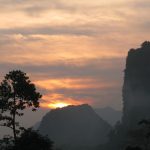My first stop was Tarlac City, the provincial capital that pulses with an energy different from Manila’s frenetic pace. Here, the rhythm is steadier, more deliberate. At the city’s heart, the San Sebastian Cathedral stands as a proof to both faith and history, its pale yellow facade gleaming in the morning light. Local vendors arranged their wares in the adjacent plaza, the air rich with the scent of freshly baked pandesal and brewing kapeng barako.
“You must try our chicharon,” insisted Lara, an elderly vendor who had been selling the crispy pork rinds from the same spot for over three decades. Her weathered hands offered me a paper bag full of the local delicacy, different from what I’d tried elsewhere – crunchier, with a depth of flavor that spoke of carefully guarded family recipes passed down through generations.
The real revelation came when I ventured into the countryside. Just outside the city, the Tarlac Recreational Park offered an unexpected oasis. Local families gathered around picnic tables under ancient acacia trees, while children splashed in the swimming pools. But it was the view of Mount Pinatubo in the distance that caught my attention – the volcano that had transformed this region’s landscape in 1991 now stood as a silent sentinel on the horizon.
I spent the afternoon at the Capas National Shrine, a sobering memorial to the Filipino and American soldiers who endured the Bataan Death March during World War II. The obelisk reached toward the sky like a finger pointing to heaven, while the surrounding grounds, meticulously maintained, whispered stories of sacrifice and survival. An elderly caretaker named Bonifacio shared his father’s accounts of those dark days, his voice carrying both pride and sadness as he spoke of the region’s role in this pivotal moment in history.As the day waned, I found myself in the municipality of Gerona, where I had arranged to stay at a traditional hacienda. The old Spanish colonial house sat amid vast sugarcane plantations, its wooden floors polished by generations of footsteps. My host, Doña Elena, was a repository of local knowledge, her family having worked these lands since the Spanish era.
“Tarlac is the melting pot of Luzon,” she explained over dinner, serving me a feast that reflected this cultural fusion. There was paksiw na lechon, leftovers from a recent fiesta transformed into a sour stew; dinuguan that spoke to Kapampangan culinary prowess; and a unique local version of pinakbet that showed Ilocano influences. Each dish told a story of migration, adaptation, and the blending of traditions.
The next morning, I rose before dawn to visit the Monasterio de Tarlac atop Mount Resurrection. The winding drive up the mountain was an adventure in itself, but the reward was worth every hairpin turn. The monastery, home to a relic of the True Cross, offered panoramic views of the surrounding plains. In the early morning light, I watched as monks went about their daily routines, their presence adding to the profound sense of peace that permeated the mountaintop.Later that day, I explored the lesser-known corners of the province. In the town of Bamban, I discovered a community of Aeta people, indigenous inhabitants whose ancestors had lived in these lands long before the Spanish arrived. Despite the encroachment of modern life, they maintained many of their traditions, including sustainable farming practices and traditional healing methods. A young Aeta guide named Rio showed me their mountain trails, pointing out medicinal plants and sharing stories passed down through oral tradition.
As my time in Tarlac drew to a close, I found myself at the Luisita Golf and Country Club, not to play golf but to watch the sunset. The manicured grounds offered a stark contrast to the working agricultural lands that surrounded it, yet somehow both felt authentically Tarlac. A group of local businessmen invited me to join them for San Miguel beer and sisig, and our conversation drifted from politics to family to dreams for the province’s future.
“People think they know Tarlac,” one of them said, “but they only know what they see from the highway. The real Tarlac is in the stories we tell, the food we share, the way we welcome strangers as family.”
Looking back, I realized that Tarlac’s charm lies not in grand tourist attractions or spectacular landmarks, but in its ability to surprise those who take the time to look closer. It’s a province that reveals itself slowly, through conversations with locals, through meals shared with newfound friends, through quiet moments in centuries-old churches, and through the stories embedded in its landscape.The province serves as a bridge between north and south, not just geographically but culturally. It’s a place where historical narratives intersect with daily life, where traditional farming practices coexist with modern agriculture, and where different cultural traditions blend to create something uniquely Tarlaqueño.
As I packed my bags to leave, Lara, the chicharon vendor I’d met on my first day, appeared at my guesthouse with a fresh batch of her specialty. “Para sa daan,” she said – for the road. This simple gesture encapsulated everything I had come to understand about Tarlac: its generosity, its preservation of tradition, and its warmth toward visitors who choose to look beyond the highway and discover its heart.
Driving south toward Manila, I watched the sugarcane fields roll by with new eyes. Tarlac had shown me that sometimes the most meaningful journeys happen in places we least expect, in provinces we might have otherwise passed through without a second glance. In choosing to stop, to stay, to listen, and to learn, I had discovered not just a destination, but a lesson in how to travel – with an open heart, curious mind, and willingness to let a place reveal itself in its own time.










Leave a Reply